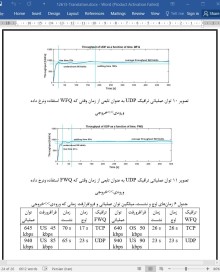
دانلود مقاله فعال سازی اینترنت اشیا توسط مسیریاب لبه ای وفقی
چکیده
در چشمانداز آیندهی شبکهها، نه تنها افراد بلکه تمام اشیا، سرویسها و رسانهها بهم متصل بوده و به صورت یکپارچه اینترنت همهچیز را میسازند. هدف سیستمهای اینترنت اشیا، اتصال و توزین میلیاردها دستگاه در حوزههای مختلف مانند حمل و نقل، صنعت، شهر/خانه هوشمند، خدمات پزشکی و سیستمهای انرژی است. فنآوریهای بیسیم و سیمی مختلف حسگرها و سیستمها را از طریق نقاط دسترسی بیسیم ، دروازهها و رهیابها بهیکدیگر متصل میکنند که به نوبهی خود به وب و هوش متبنی بر ابر متصلند. معماری IoT نیازهای جدیدی در روشهای کنترل شبکه و جهت مدیریت بهینهی مقادیر عظیم گره و داده ایجاد میکند. بنابراین، برخی از وظایف مدیریت ابر باید در مرزهای سیستمهای شبکهای و با استفاده از پردازش مه ، جهت کنترل و مدیریت منابع شبکه، کیفیت، اولیتبندی ترافیک و امنیت، توزیع شود. در این مقاله راهحلهای پردازش مرزی وفقی بر اساس کنترل پذیرش کاهنده و صفبندی وزندار فازی ارائه کردهایم که کیفیت خدمات شبکه را تحت نظر داشته و به تغییرات آن در شبکههای ناهمگن واکنش میدهد و در یک سناریوی مورد استفاده در رسانگرها ، از تکنولوژی IEEE 802.11p استفاده شده است. این راهحلهای وفقی عملکرد پایدارتر شبکه و بهینهسازی مسیر شبکه و منابع را مسیر میسازند.
1. مقدمه
اپراتورها، توسعهدهندگان و تولیدکنندگان در تلاشند تا به بخشی از انقلاب اینترنت اشیا و اینترنت همهچیز تبدیل شده و محصولات و سیستمهای جدیدی ارائه دهند. سیستمهای IoT همراه با اشیا و دستگاههای متصل بهم، تمام جهان را پوشش داده و تمام مردم در سراسر جهان تحت تاثیر آن قرار میگیرند. بنابراین، شبکههای اطلاعاتی در حوزههای کاربردی مختلف گسترش خواهند یافت که این حوزهها شامل صنعت، سامانهی ترابری هوشمند ، پوشیدنیها، بهداشت و سلامت، خانههای هوشمند، دفاتر، ساختمانها، شبکهها و شهرها است. معماری رایج IoT را میتوان به چهار سیستم متصل شامل اشیا، دروازهها/رهیابها، شبکهها و ابرها تقسیم کرد. معماری IoT کارآمد، نیازمند اشیا و حسگرهای بهقدر کافی هوشمند است تا دادههای ارسالی به ابر را فیلتر و مدیریت کنند. با این حال، اکثر حسگرها برای اتصال به اینترنت طراحی نشده و قادر به پردازش و ارسال داده به ابر نیستند، هرچند جریان انبوه داده وجود دارد. برای مثال و با توجه به سیسکو [1]، یک موتور جت 10 ترابایت دادهی مربوط به عملکرد و شرایط خود را تنها در عرض 30 دقیقه پرواز تولید میکند. انتفال تمام داده به ابر و پاسخ مربوطه به سیستم بدون هرگونه پیش پردازشی، علاوهبر مصرف منابع اندک پهنای باند باعث اتلاف زمان و سرمایهی مهرههای مختلف در زنجیرهی تولید IoT خواهد شد. برای حل این مسئله، بخشی از مدیریت داده و هوشمندی شبکه باید در دروازهها و رهیابهای متصل به سیستم توزیع شده تا عملیات پردازش مه [2] و مرزی را انجام دهند.
6. نتیجهگیری
این مقاله روشهای پردازش وفقی برای شبکهی IoT، در مرزهای شبکه جهت بهینهسازی و کنترل جریان ترافیک و منابع شبکه پیشنهاد داد. چالشهای پرداز مه در مرز رهیابها شامل مسائل QoS، تامین شبکه و مدیریت منابع است. با روش REAC، رهیاب مرزی وفقی بر عملکرد رابط نظارت میکند تا پذیرش جریان بهگونهای باشد که تراکم مدیریت شده و کیفیت خوب کاربران اولیتدار تضمین شود. ظرفیتهای برنامهریزی QoS جهت کنترل هموار و سریع ترافیک ورودی در شبکههای ناهمگن، بر اساس سطح ترافیک غالب از FWQ استفاده میکنند.
مکانیزمهای توسعهیافته به تغییرات ترافیک سریعتر واکنش نشان داده و کیفیت بهتری را برای ترافیک اولیتبندی تضمین میکنند و در عین حال، در مقایسه با روشهای کنترل و برنامهریزی سنتی که از ویژگیهای وفقی استفاده نمیکنند، عدالت جریانها را حفظ میکنند. سیستم کلی توسعهیافته به تغییرات QoS شبکه واکنش نشان داده و با معرفی فرآیند تصمیمگیری روی حذف یا نشانهگذاری جریان احتمالی یا تعیین وزن پهنای باند مجاز، باعث هوشمندی مسیر شبکه میشود. در ادامهی این کار، روشهای مدیریت ترافیک وفقی باید ارزیابی شده و مقیاسپذیری در محیطهای با مقیاس بالا آزمایش شود تا بتوان الگوریتمهای مختلف عملکرد برنامههای IoT را ادغام نمود. آزمایش این ویژگیها به عنوان SDN و NFV میتواند برای بهینهسازی منابع مفید واقع شود.
Abstract
The vision of future networking is that not only people but also all things, services, and media will be connected and integrated, creating an Internet of Everything (IoE). Internet-of-Things (IoT) systems aim to connect and scale billions of devices in various domains such as transportation, industry, smart home/city, medical services, and energy systems. Different wireless and wired technologies link sensors and systems together, through wireless access points, gateways, and routers that in turn connect to the web and cloud-based intelligence. IoT architectures make great demands on network control methods for the efficient management of massive amounts of nodes and data. Therefore, some of the cloud's management tasks should be distributed around the edges of networked systems, utilizing fog computing to control and manage, e.g., network resources, quality, traffic prioritizations, and security. In this work, we present adaptive edge computing solutions based on regressive admission control (REAC) and fuzzy weighted queueing (FWQ) that monitor and react to network quality-of-service (QoS) changes within heterogeneous networks, and in a vehicular use case scenario utilizing IEEE 802.11p technology. These adaptive solutions are providing more stable network performance and optimizing the network path and resources.
I. INTRODUCTION
Operators, developers and manufacturers are striving to become part of the Internet of Things (IoT) and Internet of Everything (IoE) revolution, creating new types of products and systems. IoT systems with connected devices and things will cover the whole world and affect all people globally. Hence, networked intelligence will spread to various application domain areas including industry, Intelligent Transportation Systems (ITS), wearables, health, smart homes, offices, buildings, grids and cities. Typical IoT architecture can be categorized broadly into four interconnected systems including things, gateways/routers, networks and clouds. Efficient IoT architecture requires that the things and sensors must be intelligent enough to filter and manage the data that they send to the cloud. However, many of the current sensors were initially not designed to be connected to the Internet and are not capable of processing and sending data to the cloud, although there can be great amounts of data flowing around. For example, a jet engine may produce 10 TeraBytes of data about its performance and conditions in only 30 minutes of flight, according to Cisco [1]. To transfer all the data into a cloud and the response back to the system without any pre-processing would consume not only the scarce bandwidth resources but the time and money of different players in the IoT product chain. In response to this problem, part of the network intelligence and data management should be distributed to gateways and routers in the interconnected systems creating fog [2] and edge computing operations.
VI. CONCLUSIONS
This paper proposed adaptive computing methods for IoT networking at the network edges to optimize and control traffic flows and network resources. The fog computing challenges at the edge routers includes e.g. QoS issues, network provisioning and resource management. With the REAC method, the adaptive edge router monitors the link performance to admit the flows to the network in a way which handles congestion and preserves good quality for prioritized users. The QoS scheduling capabilities utilize FWQ to control traffic flows according to the prevailing traffic level in a smooth and fast way in heterogeneous networks.
The developed mechanisms are able to react faster to traffic changes and guarantee better quality for prioritized traffic and at the same time preserving fairness to other flows than the traditional control and scheduling methods without adaptive characteristics. The developed overall system reacts to changes in the network QoS by determining decision making procedures on the possible flow rejection, marking, or allowed bandwidth weight assignment, thus bringing cognition to the network path. In future work, the adaptive traffic management methods need to be evaluated and the scalability tested in a large-scale environment for combining the different algorithms optimizing the performance of the IoT applications. Testing these features as SDN and NFV components would also be beneficial for the resource usage optimization.
چکیده
1. مقدمه
2. چالشها و توانمندسازهای فنآوری برای IoT
3. پردازش ترافیک و مدیریت در مرز شبکه
4. روشهای مدیریت ترافیک وفقی
5. نتایج و بحث
6. نتیجهگیری
منابع
Abstract
.1 INTRODUCTION
.2 CHALLENGES AND TECHNOLOGY ENABLERS FOR IOT
.3 TRAFFIC COMPUTING AND MANAGEMENT AT THE NETWORK EDGE
.4 ADAPTIVE TRAFFIC MANAGEMENT METHODS
.5 RESULTS AND DISCUSSION
.6 CONCLUSIONS
REFERENCES
- اصل مقاله انگلیسی با فرمت ورد (word) با قابلیت ویرایش
- ترجمه فارسی مقاله با فرمت ورد (word) با قابلیت ویرایش، بدون آرم سایت ای ترجمه
- ترجمه فارسی مقاله با فرمت pdf، بدون آرم سایت ای ترجمه



